This article first appeared in the special feature Understanding the Impact of Climate Change.
15 questions for climate change researcher Dr. Tomita (with subtitles).
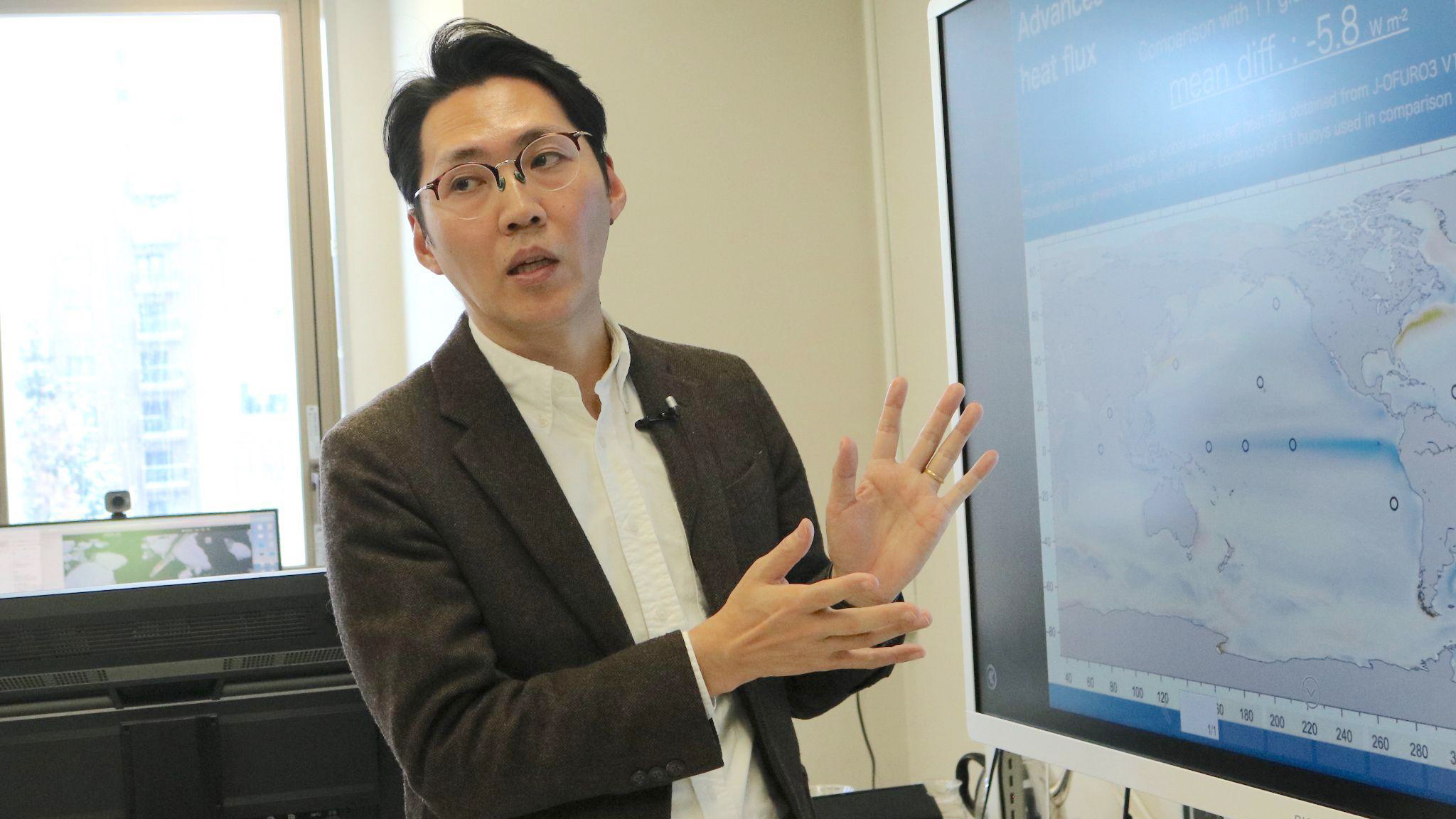
Associate Professor Hiroyuki Tomita, Faculty of Environmental Earth Sciences, Hokkaido University
The atmosphere and oceans were once studied as separate disciplines - meteorology and oceanography. However, as the atmosphere and oceans are connected by the sea surface, it is necessary to consider their interaction in order to understand climate. Associate Professor Hiroyuki Tomita of the Faculty of Earth and Environmental Sciences talks about his research that utilizes satellite observation data to accurately estimate 'air-sea fluxes' and better understand the mechanisms and effects of climate change.
Quantifying atmosphere-ocean communication
Imagine that you have a distribution map of surface water temperatures in the ocean obtained from observations. Temperatures are changing over time, so warm and cold areas change from time to time. But, it is difficult to see what causes the temperature change with the distribution map alone. One reason is that the oceans have their surface in contact with the atmosphere and exchange energy (heat) and matter (e.g., water vapor) with each other.
Therefore, we are trying to define 'air-sea fluxes' at the boundary between the atmosphere and the ocean, and quantify the exchange of energy and matter in order to gain a deeper understanding of the relationship between the two. Air-sea fluxes are, so to speak, the communication interface between the atmosphere and the ocean.
By looking at air-sea fluxes, it is possible to gain an accurate understanding of the 'atmosphere-ocean interaction,' whereby atmospheric changes affect the oceans, and vice versa. Such research can lead to more accurate forecasts of natural phenomena such as typhoons and climate change.
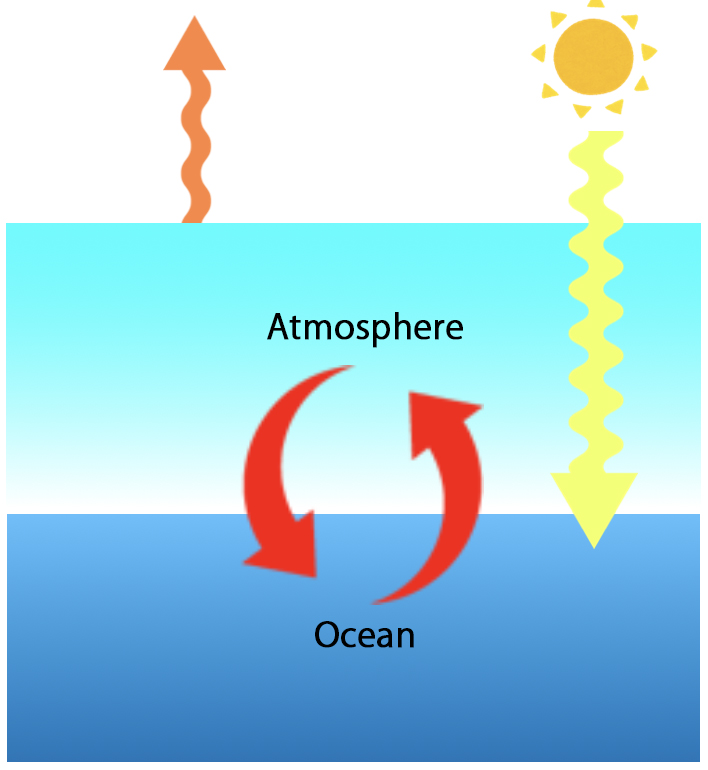
Global warming and atmosphere-ocean interaction
Heat generated by global warming is thought to be stored mainly in the interior of the oceans. However, the oceans do not store heat uniformly in the direction of depth, but tend to warm particularly at shallower depths. This is called 'stratification,' meaning the formation of layers, and it has been reported that this stratification structure tends to become more strongly stratified in relation to global warming.
Generally, when a certain amount of strong wind blows over the sea, the water near the surface mixes with the water at depth, but stratification works in the opposite direction, suppressing this mixing at depth.
When stratification makes it easier to maintain warm water in the surface layer, this creates a situation where evaporation from the ocean is more likely to occur. Greater evaporation leads to an increase in atmospheric water vapor. The increase in atmospheric water vapor in turn leads to weather effects, such as more rainfall.
This is an example of how global warming can change the interaction between the atmosphere and the oceans.
Satellite-based observations
In order to investigate these phenomena in detail, in situ observations using ships and buoys and remote sensing using satellites are used in a complementary manner. The reality is that there is very little data available for in situ observations, especially in the open ocean where access is difficult. In such areas, satellites can be used to efficiently observe large areas of ocean and estimate air-sea fluxes.
On the other hand, many of the satellite sensors I use are based on radio waves (microwaves), and these radio waves barely propagate underwater, thus only providing information near the sea surface. In such cases, it is inevitably necessary to go to the site and deploy sensors underwater to take measurements. Also, we have to observe the interior of the atmosphere to understand how the heat emitted from the oceans affects the atmosphere.
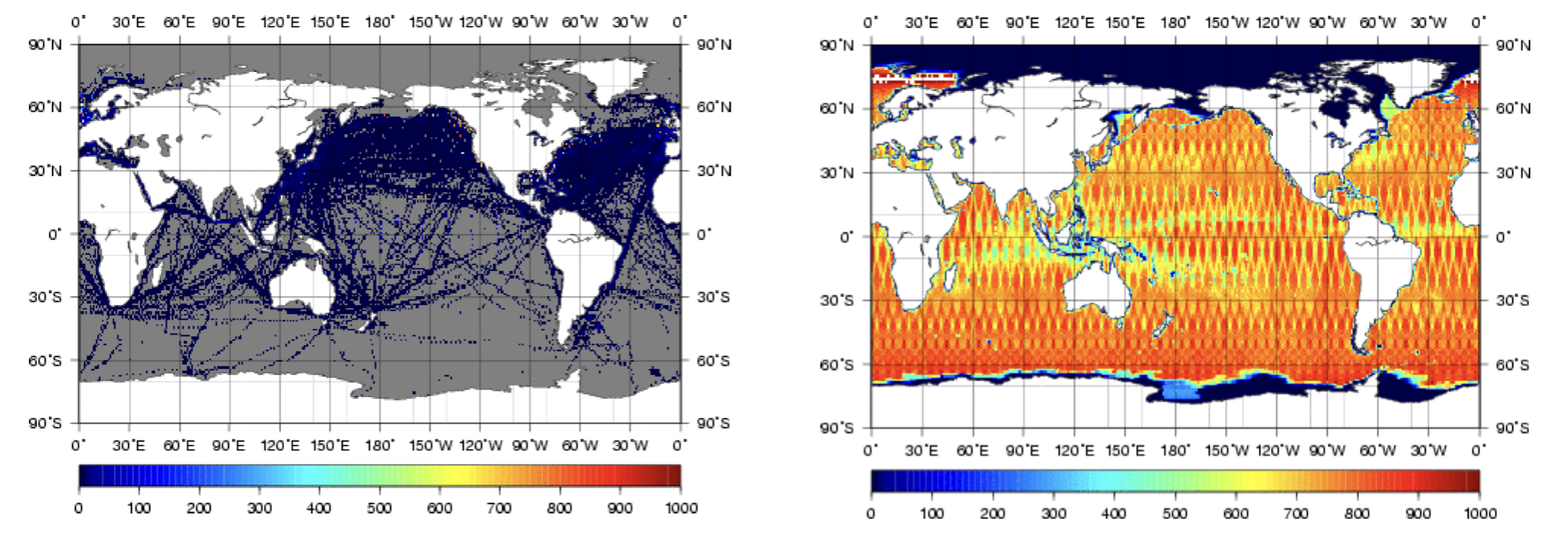
Figures showing the air-sea fluxes observed by ship (left) and satellite (right). There are gaps in the ship observations, while the satellites observe a wide area without a gap.
J-OFURO grasps global trends
J-OFURO (https://www.j-ofuro.com) is a project to estimate air-sea fluxes using data from multiple satellites. It is a project that has been running for about 20 years and has involved many researchers; currently, I lead the project.
The third generation (J-OFURO3) dataset, which is now available to the public, makes it possible to understand global air-sea fluxes. By looking at the entire warming globe, we hope to clarify what is actually happening between the atmosphere and the oceans. This broad perspective is especially important for global phenomena such as climate change.
The superposition of a large number of satellite observations has also increased the substantive resolution and revealed new discoveries. For example, we now know that there is a significant release of heat to the atmosphere in response to strong ocean currents, and that the fine eddy structure of the ocean plays an important role in the exchange of heat between the atmosphere and the ocean.
When trying to understand nature, there are two perspectives: the global perspective, which looks at the entire planet, and the detailed perspective, which looks at the smallest of details. It is difficult to understand complex phenomena such as the atmosphere and oceans, which straddle various scales, from only one perspective, and I believe it is important to combine the both in order to understand nature.
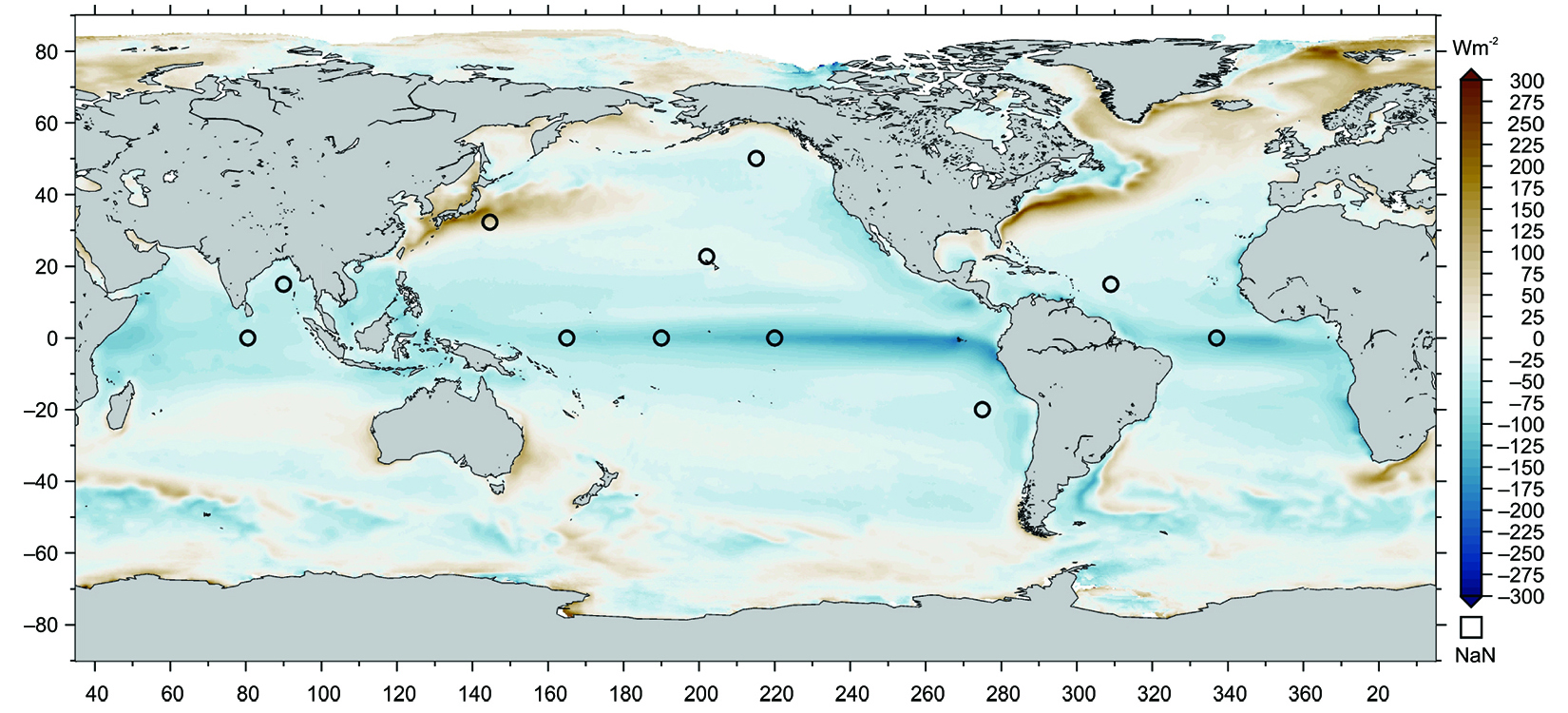
Air-sea heat flux distribution for the last three decades estimated by J-OFURO3. A positive value shows heat transfer from the ocean to the atmosphere.
Typhoon forecasts and sea surface fluxes
A particular focus of my recent work has been on typhoons. Typhoons are one of the weather phenomena that have a major impact on our society, and are strongly related to the interaction between the atmosphere and the oceans.
Typhoons are often generated in tropical oceans where the sea surface temperature is high. The warm oceans supply a lot of water vapor to the atmosphere. Then, when several conditions are met, pressure fronts form and organize, resulting in typhoons. As typhoons develop, they gradually become windier and therefore receive more and more water vapor from the oceans, causing them to develop further.
On the other hand, winds from developing typhoons also have a cooling effect on the oceans. This is because the winds stir the oceans vertically and lift cold water from below like a pump. As the water temperature drops, the typhoons in turn weaken.
The diagram below illustrates the decrease in sea surface temperature (in blue) along the path of the 2010 typhoon. This has been known for some time, but J-OFURO3 has made it possible to observe it more clearly.
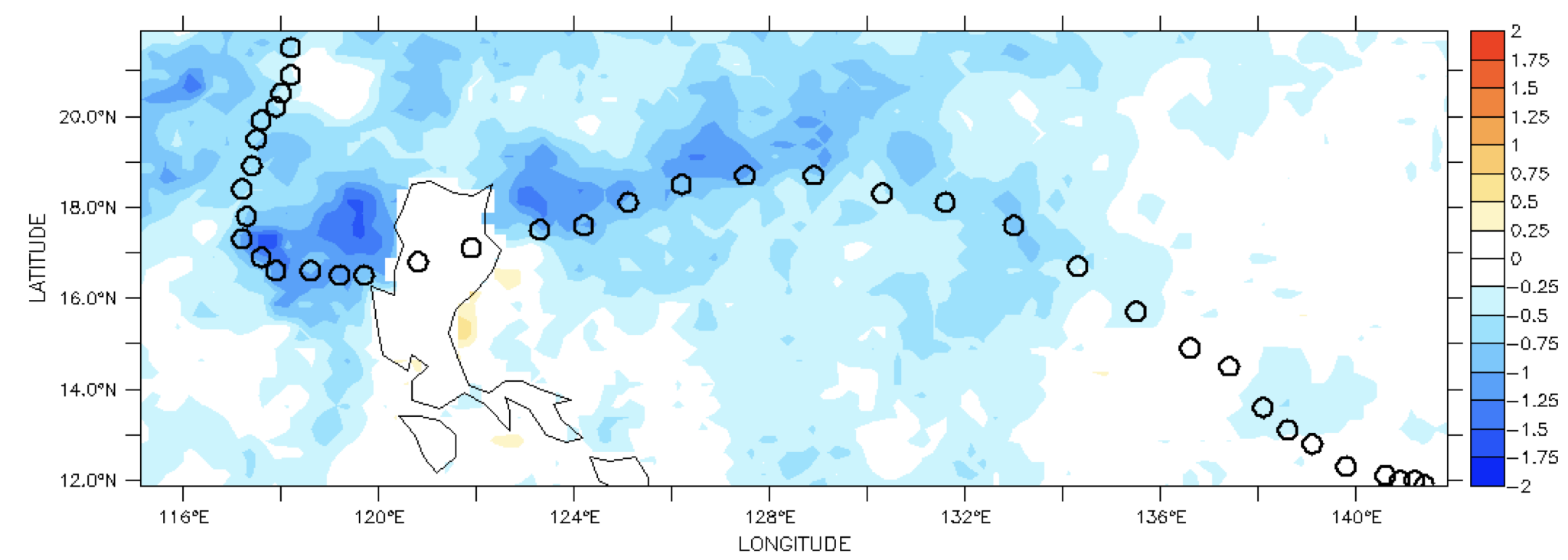
The sea surface temperature changed as a typhoon passed, observed by J-OFURO3. The circles indicate the path of the typhoon, and the color indicates the temperature difference (Kelvin).
Thus, it is only by accurately understanding the extent to which the ocean influences typhoon development that it is possible to correctly predict the intensity and path of typhoons. Accurate estimates of sea surface fluxes over a smaller area in time and space are essential for this.
This is a very challenging topic, but we are currently taking up the gauntlet. We believe that knowing this will lead to long-term predictions of changes in atmosphere-ocean interactions due to global warming.

Childhood experience of living in harmony with natureI grew up in Sagamihara City in Kanagawa Prefecture. It was rich in nature, so I spent a lot of my childhood playing in nature. There was a river called Sagami River nearby, so I used to go there every day after school, and on holidays my parents used to take me to the beach in Hiratsuka, where the Sagami River flows into the sea. There I played, catching creatures and looking at the sea. This may have led to my current interest in nature. This is also connected to my motivation for research, but I believe that for us it is important to live in harmony with nature. And I believe that this direction should still be based on scientific findings. I hope that in the future I can make a contribution somewhere in those perspectives, even if it is only a small discovery, and provide knowledge, so that future generations will find a good relationship with nature, just as I did. |
Written by Space-Time Inc.
Part of the special feature Understanding the Impact of Climate Change






